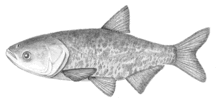Chinese Academy of Fishery Sciences
| Abbreviation | CAFS |
|---|---|
| Type | Nonprofit research organization |
| Purpose | Fisheries science and aquaculture |
| Headquarters | Beijing |
| Location |
|
Region served | China |
Membership | FishBase Consortium |
Parent organization | Ministry of Agriculture |
Staff | 1590 scientists[1] |
| Website | www.cafs.ac.cn/english/ |
The Chinese Academy of Fishery Sciences (CAFS) (simplified Chinese: 中国水产科学研究院; traditional Chinese: 中國水產科學研究院; Pinyin: Zhōngguó shuǐchǎn Kēxuéyánjiūyuàn) is a large fisheries research institute. It was founded in 1978 under the Ministry of Agriculture in the People's Republic of China. It is a leading research institution in China, active in almost all research areas to do with aquaculture and marine and freshwater fisheries.[1]
CAFS sponsors the award winning international academic periodical Journal of Fishery Sciences of China.[2] It has completed over 1,000 research projects, including a study on the aquaculture of the fleshy prawn Peneaus chinensis and the control of haemorrhage disease in grass carp, which won the National Scientific and Technological Progress First Prize.[1] The institute has contributed significantly to China's aquaculture development.[1]
Activities
Aquaculture has been pursued in China for at least 2,400 years. A tract by Fan Li in the fifth century BC details many of the ways carp were raised in ponds.[3] The major carp species used traditionally in Chinese aquaculture are the black, grass, silver and bighead carp. In the 1950s, the Pearl River Fishery Research Institute of CAFS made a technological breakthrough in the induced breeding of these carps, which has resulted in a rapid expansion of freshwater aquaculture in China.[4]
| The major traditional aquaculture carp of China | |||
|---|---|---|---|
| | |||
In the late 1990s, CAFS scientists developed a new variant of the common carp called the Jian carp. This succulent fish grows rapidly and has a high feed conversion rate. Over 50% of the total aquaculture production of carp in China has now converted to Jian carp.[5][4]
The Chinese sturgeon is an endangered species native to China. It is strictly protected by the Chinese government, who have declared it a national treasure. The Yangtze River Fisheries Research Institute of CAFS is breeding sturgeons in captivity in an attempt to restore the river population before the species disappears.[6] Some success has been claimed from artificial inducement for spawning and stream discharge for incubation.[7] During the course of the project, 5 million fish bred in captivity have been released into the wild.[8] In 2005, to mark the twentieth anniversary of China's efforts to protect the species, 10,000 sturgeon fry, 200 junior sturgeon and two adult fish were released into the Yangtze River at Yichang. However, in 2007, 14 young sturgeon were surveyed near the mouth of Yangtze compared with 600 the year before, causing concern that the battle was being lost in the crowded and polluted Yangtze River.[9]
Structure
CAFS has its headquarters in Beijing. Across China, it operates nine fisheries research institutes and four fisheries resources enhancement stations.[10]
| | ||
| Sea areas | Yellow Sea Fisheries Research Institute | Qingdao, Shandong province |
| East China Sea Fisheries Research Institute | Shanghai city | |
| South China Sea Fisheries Research Institute | Guangzhou, Guangdong province | |
| Inland areas | Helongjiang Fisheries Research Institute | Harbin, Helongjiang province |
| Yangtze River Fisheries Research Institute | Jingzhou, Hubei province[11] | |
| Pearl River Fisheries Research Institute | Guangzhou, Guangdong province | |
| Freshwater Fisheries Research Center | Wuxi, Jiangsu province | |
| Engineering | Fishery Machinery and Instrument Research Institute | Shanghai city |
| Fishery Engineering Research Institute | Wuxi Jiangsu province | |
| Marine resource enhancement | Qinhuangdao, Hebei province | |
| Changdao, Shandong province | ||
| Yinkou, Liaoning province | ||
| Changyi, Shandong province | ||
Some associated publications
- Chen D, Duan X, Liu S and Shi W (2003) Status and Management of Fishery Resources of the Yangtze River In: Proceedings of the Second International Symposium on the Management of Large Rivers for Fisheries. FAO Corporate Document Repository.
- Yulin J (1996) A Review of Traditional and Innovative Aquaculture Health Management in the People's Republic of China In: Health management in Asian aquaculture, FAO Corporate Document Repository. ISBN 92-5-103917-8.
See also
Notes
- 1 2 3 4 Chinese Academy of Fishery Science (CAFS) NOAA. Retrieved 21 July 2011.
- ↑ Journal Archived 2011-10-02 at the Wayback Machine. CAFS. Retrieved 26 July 2011.
- ↑ National Aquaculture Sector Overview: China FAO, Rome. Retrieved 26 July 2011.
- 1 2 CAFS research achievement CAFS. Accessed 26 July 2011.
- ↑ Jian, Zhu; Jianxin, Wang; Yongsheng, Gong and Jiaxin, Chen (2005) "Carp Genetic Resources of China" pp. 26–38. In: David J Penman, Modadugu V Gupta and Madan M Dey (Eds.) Carp genetic resources for aquaculture in Asia, WorldFish Center, Technical report: 65(1727). ISBN 978-983-2346-35-7.
- ↑ "Living Fossil" Fish Making Last Stand in China National Geographic, 15 August 2011.
- ↑ "Chinese sturgeon". Chinese Ministry of Culture. Archived from the original on 29 September 2012. Retrieved 28 July 2011.
- ↑ Chinese Sturgeon Set Free China Daily, 29 April 2005.
- ↑ Scientists sound alarm as Chinese sturgeon battle for survival FIS, 24 July 2007.
- 1 2 About us Archived 2011-08-16 at the Wayback Machine. Chinese Academy of Fishery Sciences. Retrieved 25 July 2011.
- ↑ Yangtze River Fishery Research Institute
External links
- Chinese Academy of Fishery Sciences main web site
Coordinates: 39°53′43″N 116°15′51″E / 39.89528°N 116.26417°E



